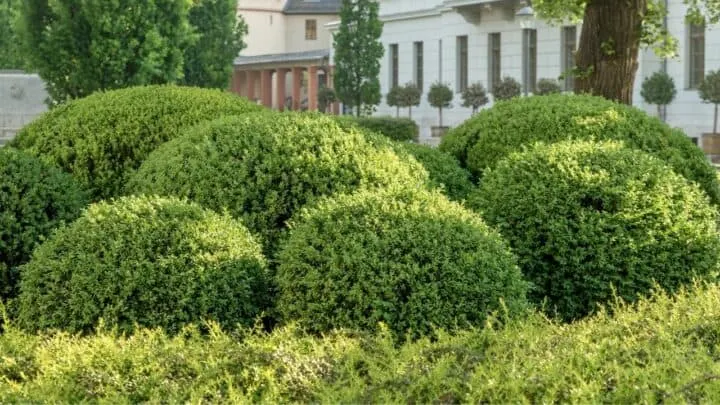A fun fact about boxwoods is that they are also known as the Man’s Oldest Garden Ornament.
The botanical name is Buxus sempervirens according to the University of Florida.
Boxwoods are easy to care for landscape shrubs that can be used to decorate your garden or backyard in any shape you desire.
They are evergreen shrubs with dense foliage, but once the foliage starts changing color, this plant needs some nutritional boost.
Boxwoods can give an elegant look to the landscape, and there are more than 200 types to choose from.
The best fertilizers for boxwoods will be the one that keeps the foliage green and healthy.
But with various market choices, gardeners are often confused about what to choose for their shrub.
Clemson University suggests conducting a soil test before applying any fertilizer.
This way you will know the exact nutrients present at your current location and know what needs to be added as fertilizer.
This guide is dedicated to finding the different options in the market to feed the Boxwoods.
Continue reading to know how people keep their Boxwoods leaves green throughout the season.
Table of Contents
Best Fertilizers for Boxwoods
The best fertilizers for boxwoods are fertilizers for acid-loving plants with an NPK value around 12-5-9. The nitrogen (N) and phosphorus (K) concentrations should be higher than the potassium (P) levels. The pH for boxwoods should be between 6.5 – 7.2 to allow for the best possible availability of nutrients. Apply boxwood fertilizer just beyond the drip line in early spring or late fall.
The Best Fertilizers for Boxwoods are
- Best Overall Boxwoods Fertilizer – Plant-tone by Espoma
- Best Continuous Release Boxwoods Fertilizer – Shake n’ Feed Trees and Shrubs Plant Food
- Best Granular Boxwoods Fertilizer – Tree and Shrub Plant Food by Nelson Plant Food
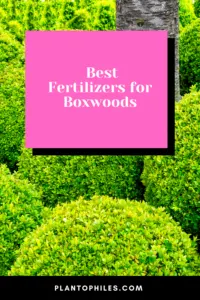
Best Fertilizers for Boxwoods
Plant-tone by Espoma – Best Overall Boxwoods Fertilizer
Plant-tone by Espoma’s is an all-purpose fertilizer capable of feeding everything in your plant collection.
Professional as well as home gardeners are always in search of products that contain natural ingredients. This special line of fertilizers by Espoma features plant foods made from 100% natural ingredients.
If you want to experience the most vibrant Boxwoods plants, feed them with this organic fertilizer. It’s guaranteed to provide long-lasting nutrients.
All these nutrients will be released slowly without causing any growth spike.
The nutrient ratio in this fertilizer is 5-3-3, but what truly differentiates it from others is the Bio-Tone.
Plant-tone should be used for the Boxwoods plants in spring and fall.
Never skip watering after adding the Plant-tone to the soil; it will not only protect the roots but also help in absorbing nutrients.
Pros
- This multi-purpose fertilizer will feed vegetables, flowers, trees, and shrubs
- Has no filler, sludge, or other harmful products
- Leftover fertilizer can be stored easily in the resealable bag
- A complete fertilizer for all types of houseplants that requires no supplement feeding
- Enriched with Bio-tone and other essential nutrients
Cons
- Has an unpleasant smell
- Can grow mold on potted shrubs
Don’t forget to buy this incredible Boxwoods fertilizer here.
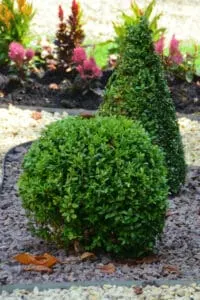
Fertilize boxwoods just beyond the drip line
Shake n’ Feed Trees and Shrubs Plant Food – Best Continuous Release Boxwoods Fertilizer
The Shake n’ Feed plant food for trees and shrubs will revive all the annuals, perennials, and evergreens in your backyard and front porch.
The natural elements in this fertilizer will feed not only the plants but also the invisible and healthy microbes in the soil. These microbes will play a major role in growing strong roots that increase water efficiency.
This plant food is high in nitrogen, and the NPK ratio is 18-6-12. It even contains earthworm castings that will eventually improve the potting and Garden soil.
This version of Shake n’ Feed is formulated to cater to the nutritional needs of acid-loving houseplants, trees, shrubs, and flowering plants.
The rich mixture will feed your plants to produce the healthiest flowers and foliage.
Continuous use will turn your Boxwoods into a lush display of green foliage. For flowering plants, it can improve the color and vibrancy of the flowers.
I would recommend utilizing this fertilizer for the starter or initial feeding as it will provide consistent nutrients for up to 3 months.
It’s worth mentioning that this plant food is designed for convenience, so you can use it for containers or in-ground Boxwoods.
This is a granular fertilizer that should be applied in dry form. But it’s crucial to water the soil afterward.
Do not apply this plant food to wet foliage. In fact, avoid any contact with the trunk or foliage.
Pros
- For shrubs growing in garden soil and containers
- The kelp, feather meal, bone meal, and earthworm castings feed the microbes living in the soil
- Nourishment for plants parts above and below the soil
- The bag can be easily opened and resealed to make sure the fertilizer stays fresh
- Increases organic matter in the soil
Cons
- Can stain the surface
- Can cause gnats infection for potted plants
Learn more about this incredible fertilizer here.
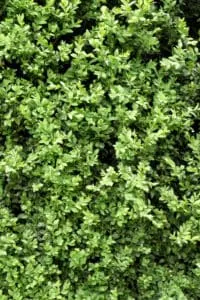
Late fall is when the roots of boxwoods grow the most
Tree and Shrub Plant Food by Nelson Plant Food – Best Granular Boxwoods Fertilizer
With 21% nitrogen, 6% phosphorus, and 8% potassium, this is my favorite granular plant food for evergreens.
Nitrogen is an important nutrient for green plants like Boxwoods, and this fertilizer has lots of it that too derived from five different sources.
This high-quality product is not just our favorite but also the top recommendation of professional landscapers for about 30 years.
These multicolored granules are also filled with micronutrients, allowing your Boxwoods to reach their full size.
This shrub fertilizer can provide nutrition for all the green plants in your garden, whether they are growing in pots or in the ground.
You can use this fertilizer at any point of the growth cycle because the granules are designed to feed your plants without burning; the aim of Nutri Star is to feed your plants with the right quantity of food at the right time.
Feeding this plant food to yellowing or wilting shrubs can immediately perk the leaves and add life to the plants.
The best time of the year to add this fertilizer is early spring or late fall; however, you can fertilize based on the nutrient requirement of your plant.
To feed multiple trees and shrubs, you should use a feeding rate of ½ cup of fertilizer for ten sq ft of landscape area.
Pros
- Ensures a steady supply of nitrogen all year long
- Can be used for other tree and shrub varieties like Maple, Mulberry, Pine, Oak, etc.
- Beneficial for the growth of lush green foliage
- Offers long-lasting nutrients for four months
- The container can be stored easily
- The sulfur in fertilizer is good for nutrient uptake in plants
Cons
- Not for flowering trees
- Cannot be used in a diluted form
Make sure to sneak a peek at this product here.
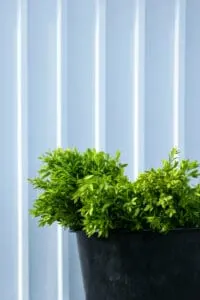
Boxwoods look and grow great in pots
Evergreen, Flowering Tree, and Shrub Fertilizer by Scotts – Best Root Growth Boxwoods Fertilizer
Boxwoods need a strong root system for healthy leaves, but for that, you need a fertilizer that encourages strong root development.
The NPK ratio is 11-7-7, meaning it has a good amount of nitrogen for root growth and has a balanced amount of phosphorus plus potassium.
If your soil is not rich, feeding plants with this fertilizer by Scotts can help the plant grow a healthy root system.
Scotts has designed this fertilizer for Azaleas, Rhododendrons, Hydrangeas, Dogwoods, among other acid-loving shrubs and trees.
This fertilizer fulfills the long-term requirements of both the gardeners and the plants.
Since it’s a continuous release plant food in granule form, you will spend less time feeding your Boxwoods, but they will always have nutrient-rich, fertile soil.
The manufacturer guarantees that this fertilizer will not burn the Boxwoods if you fertilize according to the instructions.
No worrying needed about storing these granules because the bag can be resealed.
Even the application requires little effort from your side. Simply sprinkle the granules on the soil, and you’re good to go.
The best part is this fertilizer can feed the Hungry Boxwoods for up to two months.
You should start fertilizing the Boxwoods in spring but reapply the granules every two months.
The manufacturer recommends using ½ tablespoons of fertilizer for every one sq ft. of garden area. If you buy the 3 lbs. bag, you can feed 165 sq ft of area.
Mix the fertilizer in the first 3 inches of the soil with a rake. For potted Boxwoods, you should spread the granules near the edge of the container.
Pros
- Can create an optimum soil for acid-loving plants
- Targets both root and shoot growth on trees and shrubs
- Features an easy to open, resealable bag
- No burns or root damage if instructions are followed
- Can be applied to Hydrangeas, Rhododendrons, etc.
- Easy application
Cons
- Has a strong smell
- Contains no iron
Better buy this incredible fertilizer here.

Fertilizer ensures lush green foliage in boxwoods
Tree & Shrub Plant Food Spikes by Miracle-Gro – Best for Budget Boxwoods Fertilizer
Add one spike to the soil near the Boxwoods, and your plant will not need anything else for the whole season.
Fertilizer spikes were invented to help the gardeners in treating large areas within less time. They also supply the nutrients closer to the root zone so the plant can absorb them faster before they get washed away.
This pack of 12 spikes is the budget pick because it retails for US$ 11.77 only. They promise good nutritional value as the NPK ratio is 15-5-10.
All the macro and micronutrients are continuously released within the soil.
These Miracle-Gro spikes are best suited for trees and shrubs, but you can use them for any acid-loving plant variety.
The nutrients in these spikes will enhance the color and volume of the lush green foliage of the Boxwoods.
The first application is in spring, and the second should be in the middle of fall. But ensure you don’t apply them to frozen soil. The soil for fall application should be moist and soft.
The spring application is important for young plants as they require energy to produce leaves and develop other parts.
Never insert spikes in dry soil. Always water the soil before hammering the spikes into the soil.
The drawback of these spikes is that they should be stored in a dry location.
But the original packet cannot be resealed, so you will have to look for another plastic bag or container to store the spikes for future use.
The number of spikes required per plant will vary depending on the diameter of the drip line, but each spike should be at least 2 inches deep in the soil.
The correct spacing between spikes is also important to ensure correct nutrient distribution.
A plastic cap is provided with this packet. You will need this cap for the second application so store it with your other gardening tools.
Pros
- Created with natural ingredient
- Easy to apply – no mixing or measuring for feeding
- Gives deep green color to the foliage
- Only one spike is required per season
- Supports the growth of acid-loving and evergreens
- Six months money-back guarantee
- Strengthens and promotes growth above and below the soil surface
- The packet includes a plastic cap
Cons
- Difficult to store as they need a new container or bag for proper storage
- The spikes can break during shipping
- Too strong for small potted plants
Purchase this Boxwoods fertilizer through this link.
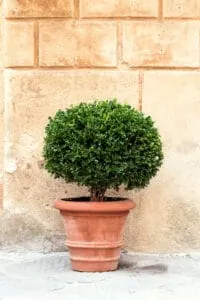
Boxwoods can be cut into almost any shape
Tree and Shrub Protect & Feed by BioAdvanced – Best Multi-use Boxwoods Fertilizer
If you want to stop worrying about pests and feeding your Boxwoods for several months, this is the product you need.
This fertilizer is designed to not just feed the plants but also protect them against pest infestations for about one year.
This product is a 12-month protection plan that can also restore the wilted or unhappy shrubs in your garden.
Everything is released slowly over a period of one year, so your plant is also protected against root burns.
The granules are provided in ready-to-use form, just measure them and sprinkle them near the base of your shrubs.
For every 1 ft. height of the Boxwoods, you will need ¾ cup of these Protect & Feed granules.
You will notice that your landscape plants will perform better as they are less vulnerable to pest infections.
This product can kill and avoid infestations of common bugs that could attack the Boxwoods or any other shrub in your garden. Before adding the granules, make sure the soil is not frozen or waterlogged.
The ideal time to add this 2-in-1 fertilizer is autumn so that the shrubs are protected throughout their active growth months, spring and summer. Repeat application every year.
The NPK ratio is 2-1-1.
Pros
- Can kill up to 40 different types of pests listed by the manufacturer
- Designed for trees, container plants, and shrubs
- Single application ensures protection for one year
Cons
- The NPK ratio might be low for some plants
Find out more about this fertilizer here.
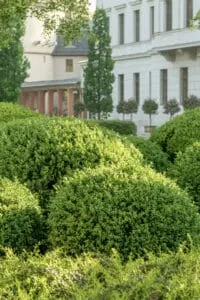
Boxwoods should be fertilized in late fall or early spring
Boxwoods Restore and Protect by TOPBUXUS – Best Foliar Boxwoods Fertilizer
This is a box of 40 tablets designed specifically for Boxwoods. It’s basically a foliar fertilizer that will feed the plant and help it grow lots of healthy green leaves.
The NPK ratio is 8-0-10, and with other minor nutrients, this is a professional grade plant food for Boxwoods.
This single box of leaf fertilizer can be used to treat 4000 sq ft of Boxwoods.
You should dissolve these tablets in water before applying them. Mix 1 tablet in 1 quart of water, giving it 10 minutes to settle.
Transfer this mixture to a sprayer and apply it to the leaves of all the Boxwoods in your Garden.
This product is dedicated to the growing needs of Boxwoods. It can also prevent leaf brown and leaf shedding to keep your landscape green.
You have to use these tablets every month in the growing months of the Boxwoods.
Pros
- This leaf fertilizer is formulated and tested specifically for Boxwoods
- Gives an instant boost to the shrubs
- It’s a bee-friendly fertilizer
- Can be used easily as a liquid solution
- Improves disease resistance
Cons
- Might require multiple applications to show the desired results
Feel free to take a closer look at this fertilizer here.
Tree and Shrub Food by Fertilome – Best Nitrogen –Based Boxwoods Fertilizer
This special tree fertilizer is not only rich in nitrogen but also feeds the feeder roots of the evergreens, fruit trees, shade, and nut trees.
You don’t need to dig any holes to apply this fertilizer. This fertilizer should be applied twice a year and each time spread ½ cup of fertilizer for every one sq. ft. of shrub area.
Each 4lbs package contains 35 pellets of fertilizer. The NPK ratio for this plant food is 19-8-10.
Pros
- Can be used on any shrub variety
- All the product is absorbed by the feeder roots
- Easy application with no holes in the ground
- Rich in nitrogen
Cons
- Not organic
- Avoid using it for potted houseplants
- Can burn the grass near the trees
Learn more about the fertilizer by clicking here.
Tree and Shrub Fertilizer by Down to Earth – Best Natural Boxwoods Fertilizer
This shrub fertilizer is designed to feed the plants with a combination of 11 special mycorrhizal fungi. The macronutrients are found in the ratios 4-2-4.
This natural plant food will be great for feeding young trees. Your Boxwoods will develop a strong root to fight against plant stresses.
This fertilizer strengthens the plant system to handle drought and transplant shock. It’s highly recommended for young plants that struggle due to environmental and plant stresses.
You should add this fertilizer during soil preparation.
Pros
- Increases protection against stresses
- Suitable for potted shrubs
- Contains fish meal and kelp meal
- Encourages fast growth
- The box can be used in compost
Cons
- Customers complained about receiving expired fertilizer
Buy this Boxwood fertilizer here.
Boxwoods Fertilizer Buying Guide
Liquid Fertilizers
Whether organic or inorganic, liquid fertilizers’ biggest benefit is the ease of application; you can fertilize your plant while watering.
You give the plants liquid fertilizers through the soil or the leaves. The foliar application gives more promising results for foliage-based houseplants.
Winner: Boxwoods Restore and Protect by TOPBUXUS
Why and When Should You Fertilize the Boxwoods
Boxwoods do not need fertilizers every other day, so you don’t need a strict fertilizing schedule for it.
However, it enjoys an occasional boost in the growing months. You should consider feeding these landscape shrubs for the following reasons:
- To strengthen it against disease and pests
- To encourage root development
- To increase organic matter in the soil
- To protect it from winter damage
Fertilization for any houseplant starts with planting them in the right soil. Incorrect feeding or soil will lead to a discolored Boxwoods plant.
The best soil for this shrub is the one that has a pH ranging from 6.5 to 7. Before adding any soil amendments, test the native soil for pH and nutrient analysis.
This test can be performed using a home kit, or you can take the soil sample to a local gardening center or nursery.
Boxwoods have shallow root systems that cannot tolerate dry conditions. The soil should be watered well to keep the Boxwoods happy and to help them absorb the nutrients.
Most Boxwoods varieties benefit from two applications of plant food:
- Spring – to encourage foliage growth
- Late Autumn – to strengthen and promote the roots for winter
Avoid adding any granular or liquid plant food to Boxwoods in hot summer and winter.
Most growers have noticed that summer fertilization results in new growth just before dormancy. This new growth is weak and is destroyed by the cold winter.
Boxwoods love nitrogen, so make sure your fertilizer has a high percentage of nitrogen for leaf growth.
In fact, if you notice the lower leaves are losing color and yellowing, immediately feed your plant with a nitrogen fertilizer.
What Happens If You Over Fertilize Boxwoods
The thumb rule;e about feeding houseplants is that overfeeding is more harmful than underfeeding.
Overfertilization can result in fertilizer burns or a dead plant. The first symptom of over-fertilization on Boxwoods is brown foliage.
Boxwoods are over-fertilized in the following ways:
- You have added more fertilizer than required. The correct level for the plant is determined based on growth and soil nutrient.
- The granules were spread very close to the base of the plant
- You left some granular fertilizer on the foliage
- You are feeding more often than required
- You applied the fertilizer to dry soil
Tips to Apply Fertilizer to Boxwoods
- If you are unsure about the quantity or dilution rates of fertilizer, always fertilize less than required. If your plant performs well, you can increase the amount of fertilizer in the next feeding session.
- If you’re using the drip irrigation method, fertilize the Boxwoods at the drip line. This is the point where the roots are located, and the water from the drip can help in distributing the fertilizer in the soil nearby.
- In addition to fertilizing, mulch the area properly to increase moisture retention.
- The root system’s spread in the soil. Therefore it’s best to fertilize a few inches away from the canopy of the Boxwoods shrub. You have to cover the entire diameter around the plant edges.
- Granular fertilizers are the top recommendation for Boxwoods.
- Avoid deep root feeding for this type of plant as it has a shallow root system that might be burned easily.
Conclusion
In simple words, the fertilizer should help the Boxwoods in producing lush green foliage and maintain the mineral content of the soil.
Hopefully, this guide helped you select the best fertilizer for boxwoods growing in your garden. The main requirement is to choose a fertilizer that is rich in nitrogen.

Daniel has been a plant enthusiast for over 20 years. He owns hundreds of houseplants and prepares for the chili growing seasons yearly with great anticipation. His favorite plants are plant species in the Araceae family, such as Monstera, Philodendron, and Anthurium. He also loves gardening and is growing hot peppers, tomatoes, and many more vegetables.

